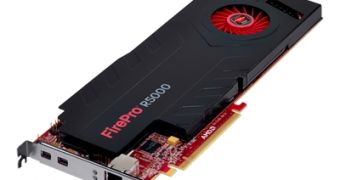Advanced Micro Devices could have challenged NVIDIA on the market of cloud-based gaming, but it seems serious in its decision to tackle markets where its rival has less of a hold.
That is why, even though, in theory, the new FirePro R5000 graphics card could have become a rival, of sorts, to the GeForce GRID, it did not.
Instead, AMD has introduced it as a means to provide centralized multi-monitor endpoints that CAD (computer-automated design), medical imaging and financial service professionals can call on.
In other words, it is made for data centers which, rather than network or web-based gaming, are meant to allow connected PCs to perform high-end operations even if they lack hardware of their own that is up to the task.
AMD didn't forget about convenience and efficiency though. That is why the FirePro R5000 has a low power draw of 150W.
Effective cooling is another asset (silent and cheap, variable fan speed), as is power management (AMD PowerTune and ZeroCore Power).
Then there is a little something called High Performance Remote Protocol. Dependent on a next-generation Teradici TERA2240 host processor, it transmits up to 300 megapixels per second to up to four monitors per end user (refresh rate of 60 fps).
Spec-wise, AMD FirePro R5000 is a single-slot video card with 2 GB GDDR5, 265-bit interface, two Mini DisplayPort outputs (up to six local displays at one), an Ethernet port, and maximum resolutions of 1920 x 1080 pixels (on up to four remote displays at 60Hz) and 2560 x 1600 pixels (on up to two remote displays when an adapter is used to combine two client ports into one).
“IT professionals are looking for a secure and straight forward cloud-based graphics solution that delivers core functionality capable of adapting to meet each employee’s unique graphics needs,” said David Cummings, senior director and general manager of AMD Professional Graphics.
“The AMD FirePro R5000 meets these needs, delivering the flexibility, functionality, security and industry-leading graphics capabilities companies look for when deciding on a remote graphics solution.”

 14 DAY TRIAL //
14 DAY TRIAL //